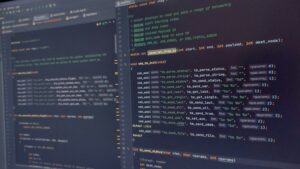The software integration engineer, a title not to be sniffed at, stands at the crossroads of chaos and order, a daring architect constructing bridges where none existed, orchestrating a harmonious integration that even the most dissonant of software entities cannot resist!
Now, imagine for a moment that you are typing—yes, typing — tenaciously into your keyboard, fingers a blur of motion, your very essence transmuting thoughts into commands, conjuring realities where applications communicate like old friends over cups of coffee. Ahh, the beauty of existence in this intricate and ever-evolving digital landscape! With each keystroke, a spell is cast, and behold! As the software integration engineer, you, my astute friend, are the casting director of this unfolding drama, curating a script that sings in perfect harmony. CI/CD pipelines—a magical incantation that breathes life into a rhythm of seamless deployment—are your realm, a pulse in the heartbeat of the engineering cosmos.
But wait—what exactly sits at the heart of this engineer’s responsibilities? Among these responsibilities unfolds a tapestry rich with the threads of collaboration, culture, and craft. Communicating effectively becomes a strong pillar, for no grand architect builds in isolation, and our gallant integration warriors are no exception! They often become the liaisons, the nexus point where divergent teams converge, dialogues blossom, and backgrounds merge, harmonizing visions into palpably realized goals. Thus, they kindle the flames of collaboration to avoid the bitter chill of disconnected efforts.
The Realm of Configuration and Version Control

Ah, behold the enigmatic world where coders masquerade as conjurers! A software integration engineer languidly dances on the precipice between disparate systems, where the air crackles with the tension of integration magic. In a labyrinth of protocols and APIs, they wield not just lines of code but artifacts—those delightful creations that emerge from the digital ether, all in the pursuit of harmony within the chaotic realm of software environments.
In this menagerie of digits and syntax, configurations are the sacred texts, whispering secrets of compatibility and collaboration. Picture a grand symphony composed of diverse instruments; each must be meticulously tuned for the orchestra to play in unison. The software integration engineer must consider not only the notes being played but also the environment in which they flourish! A Zany Engineer might scream aloud, “What if the database version is out of touch with our application framework?” Ah, but fret not, dear reader, for this expert strives to align the stars, ensuring version control reigns supreme.
Now, let us dive deeper into the swirling whirlpool of artifact management, where chaos meets order in the most spectacular fashion! Here lies the repository—a treasure chest of digital whimsies. Within its depths, the software integration engineer gleefully peers into the future, concocting a robust strategy for producing artifacts that are not merely functional but resonate with the very heartbeat of creativity. Each artifact, carefully crafted, attains a distinct version—a badge of honor that reflects growth, improvement, and adventure! And as they navigate this treacherous territory, what lies ahead is both thrilling and perilous!
In the midst of their sorcery, a software integration engineer must also be the guardian of integration testing. Ah, yes! Testing, the playful art of probing and prodding lines of code to shake loose their secrets. Just as a quirky scientist might observe a chemical reaction with bated breath, the integration engineer watches the magic unfold, seeking to uncover any hidden gremlins lurking within the shadows of their code! Will the APIs dance together, or shall they clash like titans in a bizarre gladiatorial arena? Fear not, for our intrepid engineer thrives in this environment of uncertainty, vehemently typing away, crafting validations aplenty, ensuring that every integration is more than a mere afterthought.
The Enigmatic Dance of Dependencies
Dependencies, the delightful chains that bind our beloved software to other libraries, functions, and, dare I say, entire ecosystems. For the software integration engineer, these chains must be neither too tight nor too loose, lest they risk unraveling the fabric of unity. As they skip through the garden of integrations, they must acknowledge that a single out-of-date version can bring a harmonious landscape to its knees! A veritable pandemonium of incompatibilities may arise, throwing a wrench into the carefully arranged configuration.
Let’s not forget the art of monitoring—yes, like a hawk swooping down to observe its domain. The software integration engineer must become an alchemist of alerts and logs, crafting a potion of real-time insights to keep a watchful eye on the performance of integrations. Is the data flowing smoothly? Or has it hit a snag like a duck stuck in a digital puddle? The keen eye of our daring engineer shines brightly through the fog, lighting the way to illuminate issues that would otherwise slink back into the shadows, festering within the labyrinth of dependencies.
Eclectic nuggets of wisdom and collaborative spirit float freely through the engineer’s mind. They must not only tunnel through lines of code but also weave strong relationships with the myriad teams—developing, testing, IT, and beyond—like a masterful husband (or wife) in the grand ballroom of corporate ecosystem. “Oh, dear colleagues! Let us draw ever nearer to the splendid goal of seamless integration!” they may proclaim, fingers poised in mid-air like a maestro leading a symphony into crescendo.
The Ever-Changing Landscape of Integration
Just as the seasons change, so too does the landscape of software integration. It is a wild panorama of fragmentation that transforms with each flicker of technological innovation. The software integration engineer must don their metaphorical superhero cape, always ready for the next challenge, embracing the novelties introduced by emerging technologies like microservices, serverless computing, or even the buzz of artificial intelligence! They must pivot with the ebbs and flows of frameworks, observing trends with astute acuity, always leaning into the whirlwind of change.
Beneath the comic-book-worthy bravado lies the heart of the matter: solving problems through creativity! One must ponder, what genius approach will yield the most stellar integration success? With passion and imagination, a software integration engineer crafts solutions that might make even Einstein raise an eyebrow—knowingly adding a sprinkle of the unexpected! The integrations they engineer are
Wrapping Up the Responsibilities
In the labyrinthine landscape of modern software development, where complexity reigns supreme and the stakes are perpetually escalated, the role of the software integration engineer emerges not only as essential but as an intricate tapestry woven from varying threads of disciplines and skills. Within this multifaceted role, the responsibilities that one must grasp, embody, and execute extend far beyond merely troubleshooting issues; instead, they represent a dance between meticulous management, creative problem-solving, and the relentless pursuit of seamless functionality.
A software integration engineer, one who navigates the tumultuous waters of software ecosystems, must embrace the duality of both a builder and a visionary. Managing not just the individual components that comprise a software system, but also the interplay between those elements, this role demands a keen understanding of how disparate modules, services, and processes can be carefully orchestrated to form a cohesive whole—a symphony of code that resonates with purpose and efficiency. The intricate pipelines of integration, a concept at the heart of this profession, serve not merely as conduits for data but as channels through which innovation flows. Herein lies the software integration engineer’s duty: to ensure that each build, with its myriad of intricacies and dependencies, aligns harmoniously with the overall project goals and timelines.
The Symphony of Integration

When we ponder the release cycles that govern software development, the responsibilities of a software integration engineer become even more pronounced. They must meticulously oversee the various stages of deployment, ensuring not just that each component is functioning as intended, but that they intermingle seamlessly, fostering an environment where users don’t merely adapt to a new system but rather embrace and celebrate it. Within the intricacies of release management, this engineer becomes an architect of stability, overseeing the transition from development to production with a careful eye and a steadfast hand. Each release is more than a technical milestone; it’s an opportunity to refine processes, innovate solutions, and prepare the stage for future endeavors.
In this synthesis of management and technical acumen, one cannot overlook the role of communication. It transcends the mere exchange of information, evolving into an essential lifeline that ties together the disparate teams and stakeholders involved in a software project. A software integration engineer becomes a bridge, facilitating collaboration between software developers, quality assurance teams, and even customers. The seamless transmission of ideas, coupled with a deep understanding of both technical specifications and user requirements, fosters an environment where innovation can thrive. Typing, as an act, may provoke flashes of insight, yet it is the dialogue surrounding those keystrokes that transforms it into a powerful collective vision—an expression of shared purpose.
Amidst the array of responsibilities, it remains paramount that the software integration engineer never loses sight of the bigger picture. Each integration, each build, and each release is not merely a task on a checklist but part of a broader narrative that collectively tells the story of a product, its evolution, and its ultimate place in the market. Managing expectations while striving for excellence requires not only technical prowess but emotional intelligence, as they navigate the labyrinth of organizational dynamics, differing visions, and fluctuating priorities.
In this dynamically evolving framework of technology and human interaction, embracing a mindset of continuous improvement is vital. A software integration engineer must constantly seek novel methodologies and refine existing strategies—remaining open to adapting the myriad tools at their disposal. Each team meeting, retrospectives following a deployment, and feedback from users become critical inputs flooding the engineer’s cognitive reservoir. This crucible of creativity births new ideas, fostering innovations that can elevate not just the integration capabilities but also the overall software experience for its end-users.
The Path Forward
Looking ahead, the responsibilities of the software integration engineer will likely expand and evolve further. The trends of automation, artificial intelligence, and cloud computing will continue to shape the landscape, demanding adaptability and foresight. The integration of increasingly sophisticated technologies beckons for engineers not only to maintain a semblance of normalcy but also to pioneer new paths that will define the next generation of software experiences.
Ultimately, it is this amalgamation of skills, perspectives, and sheer determination that cements the significance of the software integration engineer in contemporary software development paradigms. Within the vibrant ecosystems of code, they stand as the harbingers of cohesion, orchestrating not just the functions of systems but also the very experiences of users, affirming that through the unions they master and the challenges they conquer, they remain indispensable to the tale of technological evolution. To encapsulate, in a world where systems are perpetually intertwined, it is the software integration engineer who crafts the delicate balance, ushering in the symphony of innovation, collaboration, and delight that characterizes successful software endeavors.


